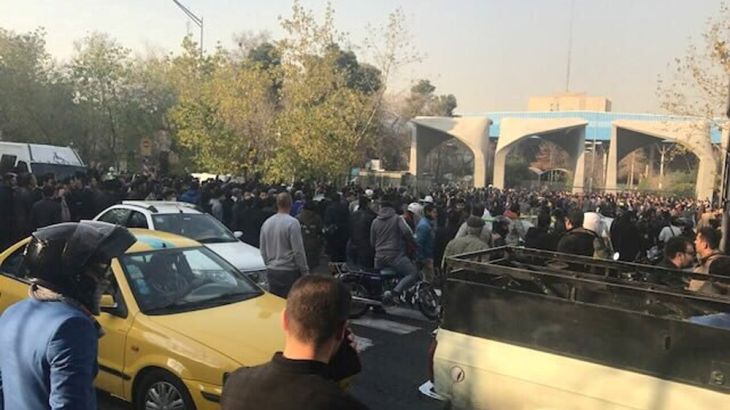Iran protests: Third day of anti-government rallies
Students clash with police at Tehran University on third day of rallies as public is told to avoid ‘illegal gatherings’.

Anti-government protests have continued for a third consecutive day in a number of cities across Iran, despite officials calling on citizens to avoid “illegal gatherings”.
Sparked by anger over Iran’s ailing economy, the rallies have gained momentum and are described as the largest in nearly a decade.
In the capital, dozens of students on Saturday chanted anti-government slogans outside Tehran University, before being dispersed by riot police and large crowds of pro-government demonstrators.
Videos posted on Twitter by the New-York based Center for Human Rights in Iran appeared to show police in riot gear clashing with protesters outside the gates to the Tehran University. A second video showed smoke-shrouded streets, purportedly from tear gas, in the same area.
Al Jazeera could not authenticate the footage, but semi-state news agency Fars also reported confrontations between police and protesters at Tehran University.
#IranianProtests: The crowd shouts "Shame on you!" as security forces beat protestors at Tehran University earlier today in #Iran. pic.twitter.com/UucJEFi8qG
— IranHumanRights.org (@ICHRI) December 30, 2017
Small crowds of protesters also rallied in Shahr-e Khord and Kermanshah, according to photos and videos posted on social media on Saturday.
The rallies appeared to take place despite Interior Minister Abdolrahman Rahmani Fazli calling on people earlier in the day not to participate in what he called “illegal gatherings”.
The protests first broke out on Thursday in Masshad, Iran’s second-largest city, with people taking to the streets to denounce a surge in the prices of basic foods, the sluggish economy and unemployment.
The rallies spread to Tehran and other major cities on Friday. Dozens of arrests were also reported.
![Pro-government demonstrators rallied in Tehran on Saturday [Hamed Malekpour/AFP]](/wp-content/uploads/2017/12/ad4331e0851c45e69b0bded612309cdc_18.jpeg)
Meanwhile, tens of thousands of people across Iran attended preplanned pro-government rallies on Saturday to mark the end of unrest following the country’s 2009 election.
State TV aired footage showing people in several cities waving flags and carrying banners bearing the image of Supreme Leader Ayatollah Ali Khamenei.
The large demonstrations, which were organised weeks ago, are held every year.
This year, however, they took on new significance, offering a show of support for Iran’s leadership in the wake of the anti-government protests.
Also on Saturday, Iran hit back at the US after President Donald Trump said Tehran “should respect its people’s right to express themselves”.
“The world is watching!” Trump wrote in a Twitter post late on Friday, while also accussing Iran’s government of corruption and funding “terrorism abroad”.
Many reports of peaceful protests by Iranian citizens fed up with regime’s corruption & its squandering of the nation’s wealth to fund terrorism abroad. Iranian govt should respect their people’s rights, including right to express themselves. The world is watching! #IranProtests
— Donald J. Trump (@realDonaldTrump) December 30, 2017
In response, Bahram Qassemi, spokesman for Iran’s foreign ministry, called the US president’s warnings “cheap, worthless and invalid”, according to the semi-state news agency Fars.
“Iranian people feel no value for the opportunistic claims of the US officials and Mr. Trump, himself”, Qassemi was quoted as saying.
‘Iranians will reject US statements’
Under Trump’s administration, Washington and Tehran have grown further apart, clashing on foreign policy issues such as the wars in Syria and Yemen and over the 2015 nuclear deal with world powers.
Some analysts rejected the US’ comments as simply driven by politics.
Trita Parsi, founder and president of the Washington, DC-based National Iranian American Council, said: “The fastest way to discredit these legitimate grievances expressed by the Iranian people, is for Trump to throw himself into the mix.”
Amir Handjani, a New York-based fellow at the Atlantic Council think-tank, said: “Anything the Trump administration says about Iran (even if it may be remotely credible) will be rejected by the vast majority of Iranians, given his position on a whole host of issues that touch on Iranian prestige and national interests.”
Iranian officials have long blamed US sanctions for the country’s sluggish economy. While many of these economic measures were lifted after the 2015 nuclear deal, some unilateral US sanctions remain.
Eshaq Jahangiri, first vice president of Iran, said that while some protesters were rallying against high prices, others were set on derailing the government.
“All economic indications in the country are good. Yes, there is an increase in the prices of some products and the government is working on fixing causes of high prices,” he said.
“The people behind what is taking place think they will be able to harm the government. But when social movements and protests start in the street, those who have ignited them are not always able to control them.”
Commenting on the anti-government rallies, Nader Hashemi, who heads Middle East studies at the University of Denver, said Iranians were frustrated about the lack of accountability from their leaders.
“It’s really the linking of Iran’s regional foreign policy – in Syria in particular – with the economic grievances that many people are feeling,” he told Al Jazeera.
“Many Iranians … do not understand why Iran has invested so heavily in regional foreign policy adventurism to the detriment of Iran’s own internal economic problems.”
A large section of society believes there is “no accountability over where money is being spent”, he said.
“The hardline elements of the regime are probably going to blame protests on foreign conspiracies. The real question is what will the Iranian government do and say in the coming days in response [to the protests]?”